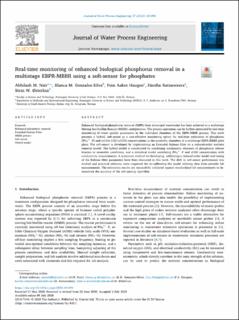Real-time monitoring of enhanced biological phosphorus removal in a multistage EBPR-MBBR using a soft-sensor for phosphates
Nair, Abhilash Muralidharan; Gonzalez Silva, Blanca Magdalena; Haugen, Finn; Ratnaweera, Harsha; Østerhus, Stein Wold
Peer reviewed, Journal article
Published version
Permanent lenke
https://hdl.handle.net/11250/2730270Utgivelsesdato
2020Metadata
Vis full innførselSamlinger
Originalversjon
Nair, A. M., Gonzalez-Silva, B. M., Haugen, F. A., Ratnaweera, H. & Østerhus, S. W. (2020). Real-time monitoring of enhanced biological phosphorus removal in a multistage EBPR-MBBR using a soft-sensor for phosphates. Journal of Water Process Engineering, 37, 101494. https://doi.org/10.1016/j.jwpe.2020.101494Sammendrag
Enhanced biological phosphorus removal (EBPR) from municipal wastewater has been achieved in a multistage Moving Bed Biofilm Reactor (MBBR) configuration. The process operations can be further optimized by real-time monitoring of water quality parameters in the individual chambers of the EBPR-MBBR process. This work presents a hybrid, soft-sensor as a cost-effective monitoring option for real-time estimation of phosphates (PO43−-P) and soluble COD (sCOD) concentrations in the anaerobic chambers of a multistage EBPR-MBBR pilot plant. The soft-sensor is developed by implementing an Extended Kalman filter on a reduced-order nutrient removal model. The hybrid model is constructed by combining mechanistic elements of phosphorus release kinetics in anaerobic conditions, and a statistical model correlating PO43−-P and sCOD concentration with conductivity measurements. A systematic method for developing, calibrating a reduced-order model and tuning of the Kalman filter parameters have been discussed in this work. The drift in soft-sensor performance was studied and practical solutions were suggested for re-calibrating the model utilizing data from periodic lab measurements. The estimation results are successfully validated against standardized lab measurements to demonstrate the accuracy of the soft-sensing algorithm.

